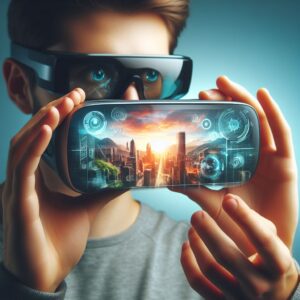Introduction: Through a New Lens
Augmented Reality (AR) has transitioned from a futuristic concept to a tangible reality, transforming the way we interact with the world around us. At the forefront of this technological evolution are AR glasses and a myriad of augmented reality gadgets. In this article, we delve into the realm of AR technology, exploring the capabilities, applications, and potential impact of AR glasses.
AR Glasses: A Vision of the Future:
AR glasses represent a groundbreaking leap in wearable technology, merging the physical and digital worlds seamlessly. Devices like Microsoft HoloLens, Google Glass, and more recent entrants into the market, aim to enhance our visual experiences. These glasses typically feature transparent displays, allowing users to see both the augmented content and their physical environment simultaneously.
Immersive Experiences Beyond Screens:
AR glasses offer users a departure from traditional screens, ushering in a new era of immersive experiences. Whether navigating city streets with turn-by-turn directions, exploring educational content through holographic displays, or playing interactive AR games, these glasses provide users with hands-free access to information and entertainment.
Enhanced Productivity and Workplace Applications:
The workplace is poised for a transformation with the integration of AR glasses. From providing on-the-job training with interactive tutorials to aiding professionals in complex tasks with real-time information overlays, AR glasses enhance productivity and efficiency. Industries such as manufacturing, healthcare, and logistics are already exploring the potential of AR glasses to streamline workflows.
AR Gadgets for Everyday Life:
Beyond AR glasses, a variety of augmented reality gadgets have emerged to enhance daily life. Devices like smart mirrors, AR navigation devices, and AR-enabled smartphones are incorporating augmented reality to provide users with valuable contextual information. For example, AR navigation can overlay directional arrows onto the real-world view through a smartphone camera.
AR in Retail and E-Commerce:
Augmented reality is revolutionizing the way we shop, both online and offline. AR glasses and gadgets enable users to visualize products in their own space before making a purchase. Virtual try-ons for clothing, furniture placement in homes, and even virtual previews of cosmetics are becoming commonplace.
Cultural and Educational Applications:
AR glasses and gadgets are finding applications in cultural and educational contexts. Museums and historical sites can use AR to provide additional information and interactive exhibits. Educational content can be brought to life through augmented reality.
Challenges and Future Developments:
While AR glasses and gadgets hold tremendous potential, there are challenges to overcome, including concerns about privacy, user acceptance, and the need for robust and reliable AR content. The future development of AR technology will likely involve through a New Lens improvements in battery life.
Conclusion: Through a New Lens
AR glasses and augmented reality gadgets are transforming the way we perceive and interact with the world, offering a glimpse into a future where the boundaries between the physical and digital realms are blurred. As these technologies continue to evolve, their impact on various industries and aspects of daily life is expected to grow exponentially. The journey through this augmented reality landscape promises to be an exciting and transformative one.
For more Article like this, visit our Website Here

